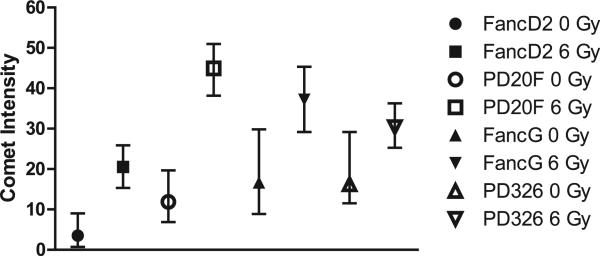FIG. 4.
Decreased radiation induced DNA strand breaks by comet assay correlates with relative radioresistance of Fanc-G–/– (PD326) cells compared to Fanc-D2–/– (PD20F) cells. Cells were irradiated to 0 or 6 Gy and collected 10 min after irradiation. The cells were prepared for the neutral comet assay, which measured double-stranded DNA breaks by plating in low-melt agarose, then treated with protease and RNase to leave the DNA only. The DNA was electrophoresed and stained with a fluorescent dye as described in the Methods. The tail intensity was determined, with a higher tail intensity indicating increased DNA strand breaks. The Fanconi anemia cell line comet intensity was compared for eight groups (Fanc-D2 0 Gy, Fanc-D2 6 Gy, Fanc-G 0 Gy, Fanc-G 6 Gy, PD326 0 Gy, PD326 6 Gy, PD20F 0 Gy, PD20F 6 Gy). Because there were multiple 0 values in some of the groups, and because the test for normality was rejected for most of the groups, the two-sided Wilcoxon rank sum test was used to test the difference between any two groups. Data were summarized by median and interquartile range (IQR) correspondingly. In each group, data are restated as median, interquartile range (IQR), and sample size (n). P values were calculated for the comparison between any two groups with the two-sided Wilcoxon rank sum test. For all tests, P values of less than 0.05 were regarded as significant. All the tests had significant P values except the one comparing PD326 and Fanc-G cells at 0 Gy. Fanc-D2–/– (PD20F) cells had more DNA strand breaks (comet intensity) than Fanc-G–/– (PD326) cells (P < 0.0001). Gene-corrected Fanc-D2 cells and Fanc-G cells were more radioresistant or radiosensitive than parent lines (P < 0.0001), consistent with clonogenic survival curve data.

